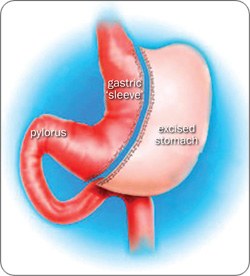Sleeve gastrectomy

The new stomach tube, or pouch, is about a quarter of the size of the original stomach. Unlike a gastric bypass where food enters a small pouch and then passes straight into the small bowel, the route that food takes following a sleeve gastrectomy is the same as it took before surgery.
The sleeve gastrectomy can be performed as a single operation. Most people will lose between 30-50% of their excess weight. Weight loss is generally quite fast, as with the bypass procedure, however because you have a larger stomach capacity, and the intestines are not bypassed, most people do not lose as much weight as with the gastric bypass.
Often the procedure will be used as the first stage of a 2-stage procedure, if the surgeon feels it is too risky to proceed straight to a gastric bypass. If this is the case, you will have the sleeve gastrectomy and then after some weight loss has occurred (9–18 months after the first surgery) the second operation can be scheduled.
Expectations of weight loss
Most people lose weight quite quickly over the first year following a sleeve gastrectomy. Most people lose between 30–50% of their excess body weight, although this can vary and some may lose more.
Adherence to dietary advice will result in greater weight loss and better weight maintenance. The dietitian will discuss with you what changes you would need to make to your eating patterns to have the best weight loss results.
Advantages
- Surgery can be offered to patients who are at a high risk for progressing straight to the gastric bypass
- The amount of food you can eat is restricted
- You are likely to feel fuller quicker and stay fuller for longer
- Weight loss starts from the time of surgery
- Weight loss tends to be faster than following the gastric band
- You can lose on average 30–50% of your excess weight
- As with the band, your intestines remain intact so food is digested and absorbed as normal
- The surgery can then be followed by conversion to the gastric bypass or duodenal switch resulting in further weight loss
Disadvantages
- The surgery itself has more risks than the gastric band because it is a longer procedure and the stomach is cut
- You may not lose as much weight as following the bypass and you may be at more risk of regaining weight
- Your hair may thin—this is temporary while losing weight at a rapid rate
- You may develop gallstones due to rapid weight loss—it may be necessary to undergo a further operation to remove your gallbladder, although this is quite rare
- Most of your stomach is removed—this is a permanent procedure
- Nausea and vomiting may occur, particularly in the first few days after surgery—vomiting is also common if you eat too quickly, or eat too much
- You will need to take a tablet daily to reduce stomach acidity
- You will have better results if you follow dietary changes and have self control

